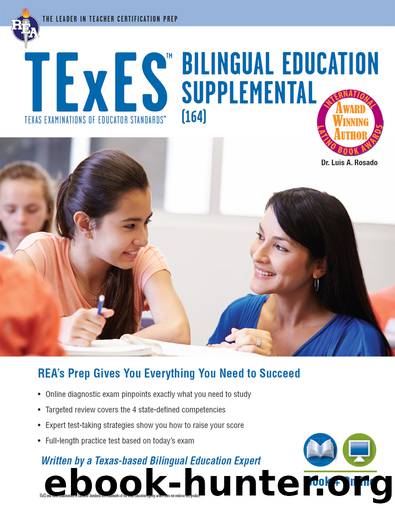TExES Bilingual Education Supplemental (164) Book + Online by Rosado Luis A.;

Author:Rosado, Luis A.;
Language: eng
Format: epub
Publisher: Research & Education Association
Published: 2018-08-15T00:00:00+00:00
Dialogue: Teaching dialogue includes more than the social aspect of communication. It includes the dialogue needed to share and obtain information in language as well as the content areas. It requires students to learn to ask questions and to communicate information through dialogues. It requires students to present a logical, linear, and connected progression. It also requires speakers to understand the norm used to join, develop, and close conversations. Speakers also must use the appropriate register for the conversations to deliver the intended message. Teaching the language structures mentioned earlier can also improve the participation of students in dialogues.
Reading: English and Spanish are similar but with unique characteristics that merit careful consideration when implementing programs to develop biliteracy. When comparing English and Spanish, we find English characteristics that do not transfer to Spanish. For example, English literacy emphasizes the name of the letters of the alphabet with the sound they produce. Since consonants in English are more consistent than vowels, the consonants are used as a foundation for initial reading instruction. They use the connection of the letters and sound to introduce decoding strategies or word attack skills. This phonemic awareness is fundamental for the teaching of English reading.
In Spanish, teachers also introduce the letters of the alphabet with the sounds they represent. Since Spanish vowels are more consistent than the consonants, teachers use vowels and consonants to create syllables. These syllables represent the foundation for introducing initial reading instruction. Students are guided to recognize syllables and connecting them with others to create words. This does not mean that Spanish is a syllabic language, however. It just means that for reading instruction, the unit used is the syllable, not isolated sounds. Therefore, teachers must use the features of Spanish as foundation to begin literacy instruction instead of using English literacy principles.
Despite differences, multiple common strategies can still be used to achieve biliteracy. Some common components used to achieve biliteracy rely on paired literacy, authentic literature, and literature-based English language development instruction.
Paired Literacy is the preferred model to promote biliteracy among ELs. In this model literacy in L1 and L2 is introduced simultaneously in kindergarten through at least 5th grade. This model is typically used in the 50â50 dual language models. This approach differs from the traditional transitional bilingual education programs. In traditional programs, literacy instruction is presented sequentially, with literacy instruction first presented in L1 and followed by formal instruction presented in L2. Traditional instruction thus relies on the transfer of concepts from L1 to L2.
Authentic Literature is more appropriate to promote literacy in both languages because this literature uses the internal structure and characteristics of the target language and not the superimposed component of translated materials. This literature is also more appropriate because students may have the background knowledge needed to understand the story. If possible, teachers should avoid using translated versions of literature.
Literature-based English language development is one of the principles of whole language instruction. This approach uses literature as a foundation for the introduction of literacy skills
Download
This site does not store any files on its server. We only index and link to content provided by other sites. Please contact the content providers to delete copyright contents if any and email us, we'll remove relevant links or contents immediately.
1,001 ASVAB Practice Questions For Dummies by Powers Rod(4045)
ASVAB For Dummies by Powers Rod(2465)
Police Exams Prep 2018-2019 by Kaplan Test Prep(2039)
Churchill by Paul Johnson(2016)
Wiley CPA Examination Review Focus Notes by Kevin Stevens(1617)
Wonder by R J Palacio(1609)
First Aid Handbook--Crucial Survival Skills, Emergency Procedures & Lifesaving Medical Information by Department of the Army(1508)
1936941139 (N) by Bob Rosenthal(1506)
A Very Stable Genius by Philip Rucker & Carol Leonnig(1339)
ASVAB AFQT For Dummies by Rod Powers(1321)
1,001 ASVAB AFQT Practice Questions For Dummies by Angie Papple Johnston(1178)
U.S. Army Combat Pistol Training Handbook by Army(1151)
CISSP For Dummies by Miller Gregory Peter(1140)
The GED Crash Course by Alpha(1115)
Court Officer Exam by Learning Express LLC(1067)
Master the Civil Service Exams by Peterson's(1060)
McGraw-Hill Education 2,000 Review Questions for the CPA Exam by Denise M. Stefano(1060)
Master the ASVAB by Scott Ostrow(1053)
Future Design by Unknown(1021)
